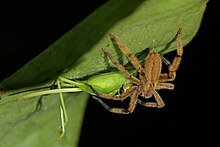Fishing spiders (family)
| Fishing spiders | ||||||||||||
|---|---|---|---|---|---|---|---|---|---|---|---|---|

Great wandering spider ( Cupiennius salei ) |
||||||||||||
| Systematics | ||||||||||||
|
||||||||||||
| Scientific name | ||||||||||||
| Trechaleidae | ||||||||||||
| Simon , 1890 |
The family of the fishing spiders or long-legged water spiders ( Trechaleidae ) belongs to the superfamily of the Lycosoidea within the order of the web spiders . The family, which is represented almost without exception in Central and South America , is made up of quite large species of spiders with the ability to move successfully on and under water.
features
The species in the family are comparatively large spiders with long legs, corresponding to the second common name. The physique of the spiders is reminiscent of that of the closely related hunting spiders ( Pisauridae ) and other families of the superfamily Lycosoidea. Like the comb spiders ( Ctenidae ), which also belong to this superfamily , the species of the fishing spider family also have quite agile tarsi , which, similar to the giant crab spiders ( Sparassidae ) , allow the spiders to move quickly and flexibly and to attach themselves well to the surface, on which they are made possible. As with the giant crab spider, the legs are laid out in a curve when resting. Like some hunting spiders, such as the rimmed hunting spider ( Dolomedes fimbriatus ), fishing spiders can also move and submerge on the surface of the water thanks to their dense hair.
Families with similar species
In addition to the representatives of the hunting and comb spiders already mentioned, some of the Selenopidae family also resemble those of the fishing spiders .
Occurrence
The family of fishing spiders is represented in the American double continent, although only the species Trechalea gertschi is also present in North America ( US states Arizona & New Mexico ). The species Shinobius orientalis , which is endemic to Japan, is an exception . Mostly tropical areas are inhabited.
Way of life
The species of the family are predominantly nocturnal ambulance hunters who, like most of the species belonging to the superfamily, hunt without a safety net and also do not make any living web. Due to the size of the spiders, the prey spectrum includes other arthropods as well as smaller vertebrates, including smaller reptiles , frogs and, due to their ability to swim, also small fish . As already mentioned, the spiders can reside perfectly on land as well as in bodies of water, where they either swim on the surface or dive underwater. The vegetation of the water or other elements, such as stones, are often used as a stop. Many species like to stay around and in flowing waters. Various others, however, are mostly to be found far away from water in the vegetation.
Reproduction

Similar to some hunting spiders, such as the cunning spider ( Pisaura mirabilis ), the males of some species of fishing spiders also woo females with bridal gifts in the form of spun prey. In this case, mating takes place while the female is busy eating the gifted prey. In other species, the approach takes place via courtship behavior. In all species, like wolf spiders ( Lycosidae ) , the female carries the egg cocoon attached to the spinneret. However, unlike these, the cocoon is previously opened by the female to enable the young to leave the cocoon with the help of the celicerae and placed in a "safety net" made by the female, where the young spiders stay for some time before they become independent. The female does not take care of the brood here.
Systematics
The family of fishing spiders was first described by Eugène Simon in 1890 and has undergone several changes since then, as species were both spun off from the family and included in it in the past. For example, the genus Sisenna, which initially belonged to this family, was added to the family of predatory spiders by Simon in 1898 and the genus Cupiennius, which previously belonged to the family of comb spiders, was added to the family of fishing spiders by Luis Norberto Piacentini and Martín Javier Ramírez in 2019. Today the family includes 140 described species in 16 genera.
- Amapalea Silva & Lise , 2006
- Barrisca Chamberlin & Ivie , 1936
- Caricelea Silva & Lise , 2007
-
Cupiennius Simon , 1891
- Large wandering spider ( Cupiennius salei ( Keyserling , 1877))
- Cupiennius getazi Simon , 1891
- Cupiennius coccineus F. O. Pickard-Cambridge , 1901
- Dossenus Simon , 1898
- Dyrine's Simon , 1903
- Enna O. Pickard-Cambridge , 1897
- Heidrunea Brescovit & Höfer , 1994
- Hesydrus Simon , 1898
- Neoctenus Simon , 1897
- Paradossenus F. O. Pickard-Cambridge , 1903
- Paratrechalea Carico , 2005
- Rhoicinus Simon , 1898
- Shinobius Yaginuma , 1991
- Syntrechalea F. O. Pickard-Cambridge , 1902
- Trechalea Thorell , 1869
gallery
Spider of the genus Cupiennius in a bromeliad plant in the Monteverde Biological Reserve , Costa Rica .
Male of the great wandering spider ( Cupiennius salei )
Closer view of the same specimen of the genus Syntrechalea
Individual evidence
- ↑ a b c d e f g Richard A. Bradley: Common Spiders of North America , 1st edition, 2019, pp. 116/349, ISBN 9780520315310 .
- ↑ a b c d e f g h Paul E. Hanson: Insects and Other Arthropods of Tropical America , Zona Tropical Publications, 1st edition, 2016, p. 314, ISBN 978-1-5017-0429-1 .
- ↑ a b Description of the fishing spiders on the BugGuide website ( Link )
- ↑ a b c The family of fishing spiders in the World Spider Catalog ( Link )
- ↑ a b c Rainar Nitzsche: Spinnen: Biologie - Mensch und Spinne - Angst und Toxigkeit , Books on Demand, 1st edition, 2018, p. 71, ISBN 9783837036695 .






